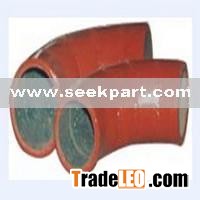Model:1/2"-72"
Send Inquiry
| Wear Resistant Elbows |
| 1. The Manufacturing Process of Wear Resistant Ceramic Lined Steel Pipe and Elbows: SHS-ceramic steel pipe and elbow create a new generation of abrasion and corrosion resistant engineering pipeline which are produced in a way of Self-propagating High-temperature Synthetic process. Wear resistant elbows are composed of three layers: ceramic, intermediate, and steel layers. The ceramic layer is formed by molten alumina at a temperature above 2500 degree. The molten alumina produced from the reaction Fe2O3+2Al=2Fe+Al2O3 spreads on the inside wall of the steel pipe under the influence of a centrifugal force, then solidifies, so the ceramic layer has high density and smooth surface and bonds to the elbow. 2.Features of Alumina Ceramic Alumina is a cost effective and widely used material in the family of engineered ceramics. Alumina ceramics have been developed and optimized for maximum wear resistance and corrosion resistance. A high density, diamond like hardness,fine grain structure and superior mechanical strength are the unique properties that make it the material of choice for a wide range of demanding applications.Ceramic has uses similar to Cast Basalt but it has greater resistance to wear in high velocity applications and impact resistance in extreme dynamic systems . 3.Product: Wear Resistant Elbows/Bends Size: DN40-DN600 Wall Thickness: 3-10mm Housing Material: Seamless Carbon Steel Inner Material: 95% Alumina Ceramic Ceramic Thickness: 3 to 6 mm Normal Operation Velocity: 20-35m/s Normal Operation Temperature: -50---800degree 4..Obvious performance of wear resistant elbows : 1. Heat-resistance, -50 - 800 Celsius degree 2. Easy Installation and Anti-Scaling 3. Abrasion-Resistance and hardness, is above 9.0 4. Corrosion-Resistance,10 times of stainless steel pipe 5. Economical Cost, 20-30% lower than that of anti-abrasion alloy steel elbows. 5.Application Fields Paper Making: For conveying pulp. Shipping: For clearing shipping channels and sediment transportation. metal Mines: For conveying tailings, concentrates and backfill minerals. Coal Preparation Plants: For conveying dense media, mixture and coal slurry. Power Plants: For deashing, deslagging, coal dropping, powder transportation |


